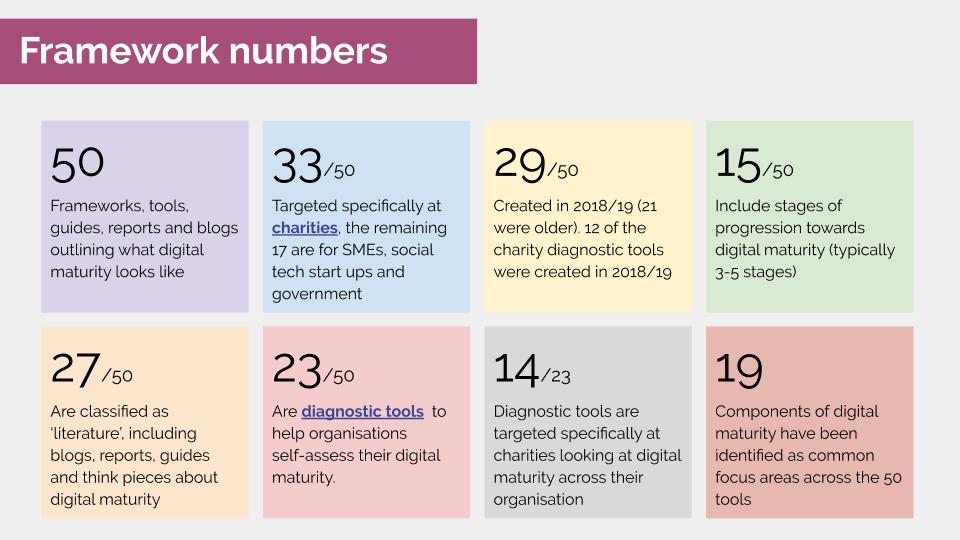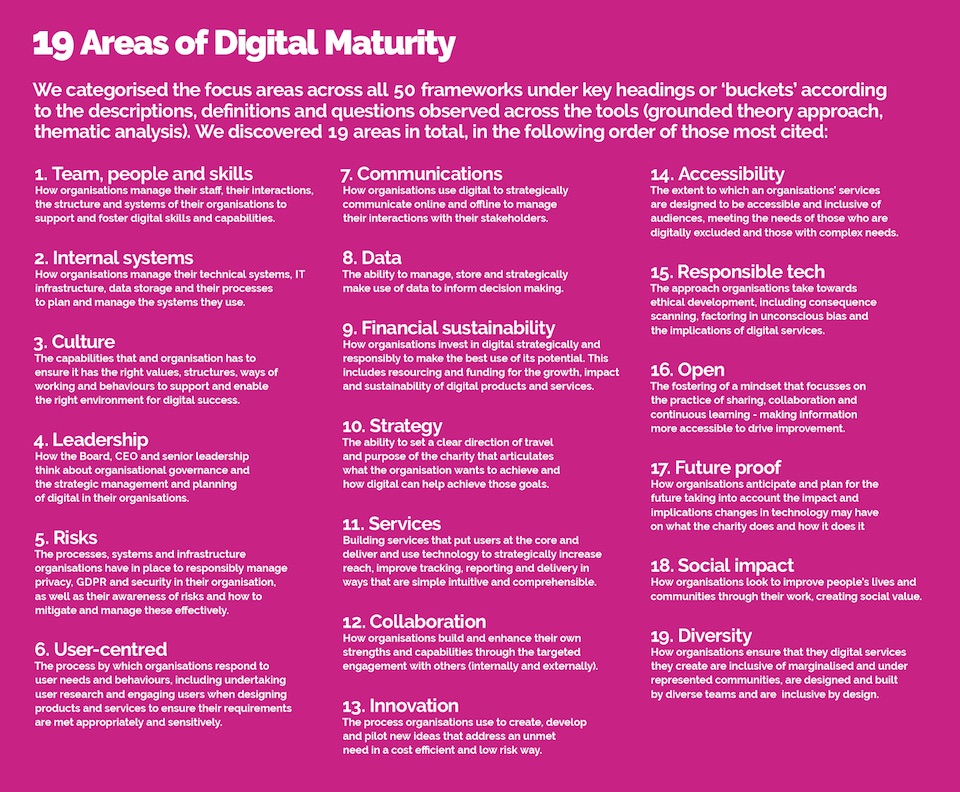Cutting through the noise surrounding digital maturity
Over the course of the last three months, Innovation Unboxed, Think Social Tech, and CAST have been building a picture of the shape and nature of digital maturity frameworks. Following contributions from a range of stakeholders (responding to this blog post), we identified 50 unique digital maturity diagnostic tools, think pieces, surveys, codes and reports in this Airtable most relevant to the charity sector. We analysed their content and identified consistent patterns in how they describe what digital maturity should look like.
What surprised us most is that despite the ‘noise’ surrounding digital maturity, there is little shared vision as to what best practice looks like. The evidence base for these tools is limited the milestones of progress are poorly defined. As a result, it is incredibly challenging to identify the most appropriate pathways organisations could follow when taking the next steps in digital. At best, each framework simply offers a starting point for what organisations should be thinking about. At worst, they risk setting unfair standards and sending charities down a path that isn’t helpful. This blog shares the resources we’ve created to help navigate this field and makes some recommendations both on what is useful and where we have identified gaps that need to be further explored. We hope it provides a foundation to build a cross-sector understanding of what digital maturity means.

Choosing a digital maturity assessment tool
When we started this project we knew we would find a lot of digital maturity frameworks, but we didn’t realise how confusing these would be to choose between, compare and use. We concluded that there is no single authoritative framework that is appropriate to recommend across the charity sector. Instead, it is worth reviewing a shortlisted selection of the ecosystem of tools out there for getting to grips with digital. We developed the following resources to help navigate through these.
- A guide to digital maturity frameworks: Intended to support those in charities to navigate the landscape of digital maturity frameworks and diagnostic tools. It recommends and describes 8 key frameworks, as well as signposting to other frameworks relevant to specific topics or types of organisations.
- A public map of digital maturity frameworks: This gives an overview of the tools on offer, listing the 50 unique frameworks, with details about the host organisation, date, target audience, description, use case, evidence base and focus areas.
- A slide deck detailing all of our findings, with further reflections on the pros and cons of digital maturity frameworks and our recommendations.
- A poster summarising our research
We hope that the resources we have put together help to fill the gap in knowledge of what exists and good practice. Longer term, we believe a shared understanding of digital maturity and best practice in describing this is needed in the social sector to help tool developers enhance their work.
The 19 areas of digital maturity
Across the 50 digital maturity frameworks, we discovered 19 common focus areas used to breakdown and describe digital maturity. Many frameworks lacked detailed milestones and indicators of progress. However, we did find consistency in how the 19 areas were described as shown in the image (also outlined in the Guide).

Coverage of these 19 areas is incredibly patchy, both across the 50 frameworks and for the 8 that we recommend in the Guide, as shown in the image below. We also found that:
- The focus areas have changed over time. There is a far greater emphasis in newer tools on risks, culture and leadership, earlier tools focus more on IT infrastructure.
- New focus areas are emerging now. There are topics that have only been covered in frameworks developed in the last 1-2 years by organisations promoting thought leadership and best practice in the social sector. This includes service design, accessibility, diversity and responsible tech, topics that will likely feature more prominently in future diagnostic tools.
- Niche focus areas may well be important. Innovation, openness, responsible tech and social impact are covered by a smaller proportion of tools. However, they are likely to be very relevant to the social sector’s use of digital. This could directly reflect a broader gap in knowledge of how best to describe, define and measure these. The focus areas are directed by tool developers. Most tools are developed on the basis of internal learning and priorities, reviewing other tools and through user testing.
Furthermore, the frameworks typically only address 7 areas of digital maturity. This divergent coverage adds another layer of complexity for organisations looking for guidance on what to prioritise. Those choosing and using a framework may not know what they don’t know, and important areas for them might be missing from the tool. We are not suggesting that these frameworks should all cover 19 different areas and indeed, we believe this could make them less helpful. However, we do feel more attention is needed about what is prioritised across different tools and where else organisations could go to learn more about other areas. Many of these frameworks stand alone and need to be better connected to support, resources and guidance to help organisations decide what next.

Finally it is important to note that diagnostic tools typically rely on self-assessment and scoring. This will directly point organisations as to where they should invest their time, energy and resources. Benchmarking scores (for example, comparing scores with similar size charities) can help manage expectations of where organisations should aspire to. However, scoring can still underplay or overplay the significance of key areas as well as the progress that needs to happen. Very few of the tools provide effective signposting and resources other than to their own services. The landscape for support looks to be competitive and as a result, fragmented.
Conclusion
It is hard to see how these tools can work more effectively without strategic investment for tool developers and a coordinated approach to developing evidence based milestones and indicators of progress. We know that there are many more diagnostic tools actively in use that are not in our list, particularly those used by consultants, as well as new tools already in development.
We believe there is a need to build the quality of digital maturity frameworks and the support surrounding them. To do this, we need to:
- Understand the journeys different types of organisations (primarily larger and smaller charities) follow in developing their digital capacity
- Identify key indicators of progress for different focus areas
- Learn from organisations who have invested in their digital maturity about the most appropriate pathways to developing digital capacity.
- Support tool developers to share what works, including insights from the use of tools
- Research how organisations come to a digital maturity tool and the extent to which scoring practices are a hinderance or a help
- Coordinate a set of best practice resources, guides and referrals to relevant support for each of the 19 focus areas
We are currently exploring options to address some of these needs and would welcome your feedback, ideas and support for continuing this project. Please do get in touch with Innovation Unboxed or Nissa or simply drop the basic details in this form or share your thoughts on Twitter.